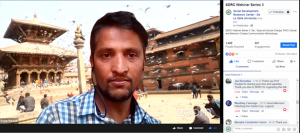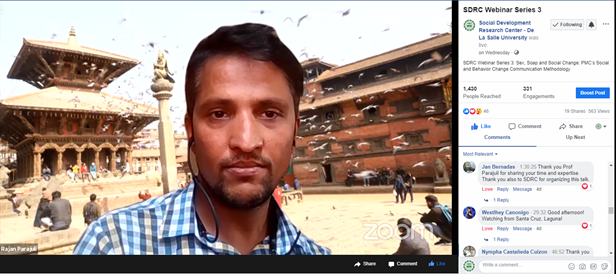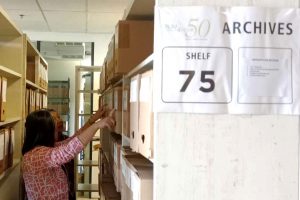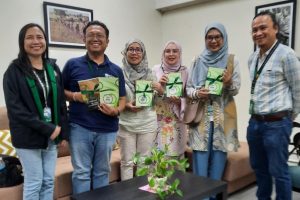Story and the Power to Shape Behavior: Third SDRC Webinar Discusses “Sex, Soap, and Social Change”
Social norms are difficult. All people do the same things, or else they face exclusion from society.
This harsh but inescapable reality was tackled by Rajan Parajuli, resident representative for the Population Media Center in Nepal, in a presentation entitled “Sex, Soap and Social Change: PMC’s Social and Behavior Change Communication Methodology.” Held on August 20, 2020 via Zoom and Facebook Live, the discussion described the approaches taken by PMC, an entertainment organization, in its goal to create changes in social norms and individual behavior, and generate demand for products or services by addressing deeply embedded personal issues.
As concrete examples of PMC’s successes with its audience, Mr. Parajuli discussed two of its productions. The first was “East Los High,” an original teen drama aired on Hulu, which garnered six Daytime Emmy nominations. Audience response to the program—which dealt with issues such as peer pressure, single parenting, and domestic violence—was expressed in feedback such as “I learned about the struggle of leaving a man when in a domestic abuse situation, instead of judging…realizing how hard it can be,” and “Made me realize that you should know your worth when you are in a relationship…”
The second production was a radio drama entitled “Agashi!” (translated as “Hey! Look again!”) aired in Burundi. Indicators of the drama’s impact on knowledge, attitude and behavior were seen in its ability to get 14% of the country’s total listeners to discuss family planning; to enable 270,000 members of the population to negotiate condom use during sexual intercourse; and to inform twice as many listeners than non-listeners of how to locate places to obtain methods of family planning.
Mr. Parajuli revealed that the “secret sauce” in PMC’s stories was the introduction of “transitional characters,” or those who find themselves between the heroes and the villains. It is the transitional characters that audiences find relatable, as they are the ones who are not extreme but are “common.” They bring a new perspective to formulaic stories by sounding more rational than the other two character types they deal with. It is the transitional characters that must make a decision in their life, having observed what has happened to the other two, and it is they who are able to avoid the pitfalls.
To fortify this innovation in its storytelling, a PMC show is developed only after having conducted formative research, wherein a baseline study is done to determine the level of the audience’s knowledge, attitude and behavior in relation to the issues being addressed in the story; consulting with an advisory committee, to be able to know the technical issues, and inform audiences of “the right steps to take,” e.g. in availing of resources and services; and recruiting local talent, so that the production can be done in the local language and within the appropriate context.
When asked how much time PMC spends in the communities to be able to carry out the methods it follows, and how it engages its audiences, Mr. Parajuli reminded participants that changing behavior takes time, and that while PMC’s shows may be appealing, it is difficult to expect audiences to apply the lessons they depict to their own lives. Shows are supplemented by PSAs, jingles, and videos. Most shows are more than two years long, and are aired twice a week, to give audiences enough time to discuss the story and remember the characters. Community discussion, talk shows, interactive theater and other outreach activities are conducted on the ground. This helps in its efforts to try to reach as big an audience as possible.
With regard to impact assessment, Mr. Parajuli shared that PMC had a strong research team, and followed ethical considerations in its studies. It was also active in monitoring and evaluation of audience response. He asserted that “We are not judgmental, we are open, and we look at the impact which is not necessarily positive.” In closing, however, he left participants with the assurance that through PMC’s intervention, new social norms and individual behavior could drive a sustained, and dramatic, change.





